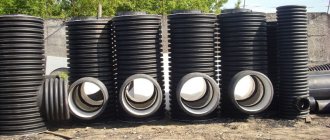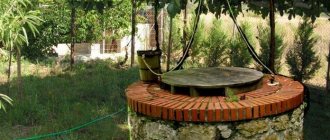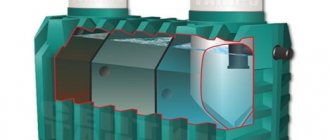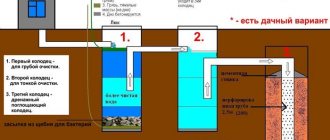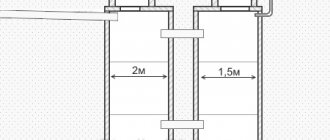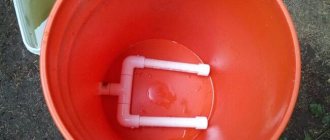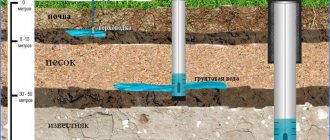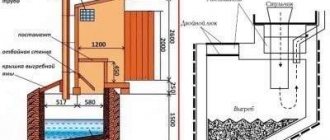Water is an important component of human life. It is used not only to satisfy the needs and comfort of the owner and his family members, but also for watering plants on the site, caring for animals and birds. In settlements where there is a centralized water supply, they do not think about its delivery.
It’s worse for those residents who are forced to bring or fetch water from somewhere else. In this case, it makes sense to dig a well on your site. The law allows you to have a well up to 20 m deep for your own needs without completing special documents.
Types of wells
A well is a shaft that reaches the water horizon with water suitable for consumption. Depending on the depth of the water layer, experts divide these hydraulic structures into two types:
- Key or superficial . This is when there is a spring in a suburban area from which the purest drinking water flows. A convenient, low-cost option.
- Shakhtny . This is when it is necessary to dig up the soil to the water layer, constructing a shaft of round or square cross-section. The depth of the structure can reach up to 10 m.
There is such a term - Abyssinian well. In the form in which we are all accustomed to seeing wells, this structure is not one. This is a well formed by a steel pipe that is driven into the ground. To raise the water, either an electric pump or a manual rocker is required. The depth of well formation is up to 30 m.
Key well on a summer cottage Source novamett.ru
Types of wells
There are three types that determine the operational supply of water inside a hydraulic structure and the method of its supply to the shaft.
- Wells of imperfect type . This type is constructed so that the shaft does not rest against solid rock. That is, the walls are formed so that the shaft of the structure is immersed in the aquifer by approximately 70%. That is, water is drawn into the well both through the walls of the building and through the bottom.
- Perfect type . This is when the mine shaft rests on solid rock. In this case, water penetrates into the well only through the walls.
- Perfect looking with a sump . The latter is a water collector, which is laid in the lower durable layer. And water enters the structure through the walls of the shaft.
Three types of water wells Source sevparitet.ru
Selecting a location
For some reason, some people think that water should be present everywhere. It is enough to make the hole deeper - and the well is ready. As a result, a wasted mine, wasted time and nerves. Moreover, the vein can pass just a couple of meters from the dug well, which remains dry.
To this day, the dowsing method is successfully used to search for a nearby water layer. Once upon a time, branches of viburnum, hazel or willow served as natural biolocators. Today, even experienced drillers often replace them with pieces of copper or aluminum wire with ends bent at 90 degrees. They are inserted into hollow tubes and, holding them in their hands, they walk through the area meter by meter. Where water passes close, the wires begin to cross in the direction of the flow. To be sure, the area is examined in this way several times.
Search using dowsing
When looking for a place for a well in your country house, you should also pay attention to the color of the greenery growing on the site. Near the water it is more juicy. Willows, meadowsweet, ivy and crabgrass are very fond of such places - where they have chosen a place to grow, there will definitely be a vein. Nettle, horse sorrel, cinquefoil, naked licorice, coltsfoot, and horsetail also grow here. But apple and plum trees, on the contrary, take root worse and often die.
Alder, willow, birch, willow and maple will always tend towards the aquifer. Single oak trees are also a sign of high standing waters. They grow exactly where they intersect.
It has long been noticed that cats love to bask in such places. Dogs avoid such areas. Red ants are also worth watching. They try to place anthills away from water. A large number of mosquitoes and midges always hover near it in the evening. In the mornings there is also always more dew and fog swirling here.
After finding the probable location of the aquifer, exploratory drilling is carried out before digging a well at the dacha. For these purposes, it is allowed to use a regular garden auger. Since you will have to go deeper by 6-10 m, its length will have to be increased. If moisture appears after digging a well, then the location of the water layer has been determined correctly.
Types of groundwater by depth
If you don't trust the old proven methods, contact a nearby geological surveyor. Such organizations always have special geophysical instruments in their arsenal that can accurately determine the proximity of an aquifer.
When the layers are below 10-15 m, the idea of digging a well should be abandoned. In this case, drilling a well will be necessary.
What to consider before starting well construction
The main requirement for arranging a well in a country house is that this hydraulic structure should provide the residents of the country house with water in full. This applies not only to drinking, but also to taking a shower, watering the garden, washing dishes, doing laundry, cleaning the house, and using the toilet. On average, one person uses up to 200 liters of water per day. That is, this is an indicator that must be taken into account when constructing a well. If in the area where the dacha is being built this indicator is not the required value, then it is worth thinking about constructing a well.
Therefore, the first step is to carry out hydraulic engineering surveys. That is, you need to make a small-diameter well and determine: at what depth the aquifer is located, what is its volume, and whether there is enough water in it. Let's face it, this service costs a lot of money. It is provided by specialized companies that have a license to carry out this type of work. But no one will give you more accurate information except them.
Of course, there is an option to ask your neighbor if there is already a well on his summer cottage. That is, the depth of his well can become a guide for yours. But this is only possible if a well is already in use on a neighboring site, and these parameters will not always suit your site.
Test drilling to determine the level of the aquifer Source obogreem-gomel.by
See also: Catalog of companies that specialize in water supply and sewerage.
Now about the question of where to install a well in the country. There are strict sanitary standards for the construction of water wells and wells, which clearly define the distances from the hydraulic structure to the facilities located on the dacha plot. Two parameters are important for a well:
- The distance from the foundation of the main house and outbuildings to the well should not be less than 5 m . This is due to the fact that the aquifer gradually washes away the soil in the lower part. And if the distance to the foundation of the building is not standard, then this may affect its integrity.
- Sanitary zone – 25-50 m . This means that at this distance from the well shaft it is impossible to build structures associated with the sewerage system. That is, you cannot build toilets, cesspools and compost pits, septic tanks, filtration fields, etc. This also applies to landfills and sewers.
Sanitary zone of a drinking well Source strojdvor.ru
And a few words about safety precautions for constructing wells. It is clear that companies offering well construction services inform their employees about what can and cannot be done when constructing a well shaft. Let's just outline some basic requirements:
- be careful when digging, because under a large layer of earth you can stumble upon a gas pocket;
- ensure that the walls of the structure do not crumble ;
- strictly follow construction technology;
- It is advisable to use modern methods and methods.
And lastly, when to start building a well for a summer house. Optimally - during the driest time. And this is mid-summer-autumn.
A well is a seemingly insignificant structure, but by law every owner must register it. Don't forget to do this after construction is completed.
It is better to build a well in mid-summer - early autumn Source wellmasters.co.uk
Basic digging tips
How to maintain vertical digging?
To control the verticality of the excavation, plumb lines are attached to the top of the shaft. Before using the next ring, you need to check the verticality of the barrel using a level.
How to level a shaft?
If the rings are already in place completely, the barrel cannot be leveled without removing them. But during the work, when only the last 1-2 m of the shaft are bent, you can dig up the bottom of the shaft in the right place and settle the entire structure, loading it from above.
Where to use clay?
To prevent the well from becoming polluted by water runoff from the surface, it is customary to make a clay castle 2 m deep and 1 m wide outside around the top of the trunk, starting from the surface. This formwork will protect the well shaft in winter from damage associated with soil heaving in the freezing zone.
What to do if you stumble upon a stone or slab?
During excavation work, you may encounter obstacles in the form of stones and even slabs. You can try to break pieces of loose rocks such as limestone and shell rock with a sledgehammer or a hammer with a hand chisel. If the boulder is large and the rock is hard, you will have to call drillers.
When can you use a well?
Immediately after the well is built and the time limits set for hardening the cement mortar are met, water is pumped out of it to 3/4 of its volume. Sometimes this procedure must be repeated several times before the liquid becomes clear. The well is now ready for use.
Technologies for constructing drinking wells
Let's start with the fact that the well shaft must have strong walls. And if in the old days they were lined with logs, today the best option is reinforced concrete rings, which are installed on top of each other, sealing the joints.
There are two main ways to form a mine: manual and mechanized. Let's start with manual.
Manual method of digging a well in the country
The technology itself is simple - a well is dug with shovels, strictly following the markings. But here the type of soil at the dacha site can interfere with the technology. It can be clayey or sandy.
In the first case, the mine is simply dug to the depth where the aquifer passes. Then reinforced concrete rings are lowered into it using a crane.
The second method is very different from the first. The thing is that it is difficult to maintain vertical planes on sandy soil. Sand is a loose and soft rock, so the walls of the mine will simply crumble and the diameter of the structure will expand. Therefore, there is a certain algorithm for carrying out this type of work.
- Make markings at the site of the well construction.
- Dig a hole with a shovel to a depth of half a meter .
- The first reinforced concrete ring is installed into it using a crane .
- A digger climbs inside and begins to select the soil. To make digging easier, the bottom of the hole is often filled with water.
The well is dug from inside concrete rings Source landshaftblog.ru
The land can be selected according to two schemes. The first is to first remove the area in the middle of the pit, and then gradually under the walls of the ring, thereby sinking it into the ground. Or vice versa: first they remove the soil under the walls of the ring, and then choose in the middle.
As soon as the first reinforced concrete ring has lowered so that part of it protrudes from the ground to a height of 10-15 cm, a second concrete ring is installed on top. And the process repeats. In this way, a well is dug, forming a trunk.
Deepening is carried out to a depth when three springs begin to emerge from the ground. That is, the process reached the aquifer. You cannot dig deeper, because the soil below is weak, and this can lead to the lower concrete ring simply sinking. Often it was distorted, after which the well was simply covered with soil, and a new one had to be dug.
Digging a hole the old fashioned way
So I dig holes and trenches the old-fashioned way, with a shovel. If you need to dig a hole that is small in diameter, you will need a good bayonet shovel, gloves for work, and thick gloves for extracting soil. As gloves for extracting soil, you can use thick gloves for working with metal (cutting, welding) with a long socket that covers the hand up to the elbow. If we dig a trench, we use bayonet and shovel shovels.
Digging has two stages that are repeated: loosening and excavation of the soil.
Loosening.
Using a bayonet shovel, we loosen the soil at the bottom of the hole or trench. To do this, we apply vertical sweeping blows with a shovel to the bottom over its entire area. To do this, the shovel must be heavy enough. If you come across particularly hard soil or compacted gravel, you can use a crowbar.
Notch.
We remove the loosened soil from the hole. If we are digging a trench or a large hole, it is convenient to do this with a shovel. If we need a hole with a small cross-section, then it is most convenient to do this with a hand dressed in a thick, high glove. Never remove soil with your bare hand or the gloved hand you are wearing. This way you will instantly wear away the skin on your hands to bloody calluses. The grains of sand will remain on your hands. During the loosening stage, they will rub against the handle of the shovel and damage the skin. In addition, you may get hurt. To avoid unpleasant infections and abscesses, you should not stain damaged areas of the skin with earth. Before excavating by hand, remove work gloves and put on thick gloves specifically designed for excavation.
We repeat the described process until the hole is the required depth.
(read more...) :: (to the beginning of the article)
| 1 | 2 |
:: Search
Unfortunately, errors are periodically found in articles; they are corrected, articles are supplemented, developed, and new ones are prepared. Subscribe to the news to stay informed.
If something is unclear, be sure to ask!Ask a question. Discussion of the article.
More articles
Why does concrete crumble, crack, or deteriorate in the foundation, walkway,... The path and foundation were poured in the summer. After winter, serious damage is visible, observing...
Do-it-yourself gates for houses, dachas, dachas. Blueprints. Installation. Make with... DIY gate installation. Scheme. Blueprints. Description…
Construction and scheme of foundation drainage…. Please tell me, is it necessary to drain the strip foundation? Soil - su...
We build the greenhouse ourselves, with our own hands. Self-assembly, installation... Do-it-yourself greenhouse, greenhouse. Drawing, diagram, description of the assembly. The greenhouse has a gray…
DIY wooden floor. Lay, lay, build. Installation, with... We install a quiet floor without squeaking forever. Repairing a squeaky floor. Procedure for...
Heat loss in the house, heat leakage... Please briefly describe the main ways of heat loss in the house...
Bignay (Salamander tree) - Fertilizer, benefits, application, contra... How to properly fertilize bignay. Where is it used, to whom is it contraindicated...
Knitting. Autumn memories. Foliage. Drawings. Pattern patterns... How to knit the following patterns: Autumn Memories. Leaves. Detailed instructions...
Arranging the bottom of a well
To ensure that the water in the well structure is always clean, it is necessary to form a so-called bottom filter at the bottom. To do this, crushed stone or gravel of a coarse fraction (40 mm) with a layer thickness of 15-20 cm is poured onto the bottom, and crushed stone of a medium fraction (10-20 mm) is poured on top with a layer of 20-40 cm.
Some old and experienced craftsmen recommend first laying a wooden platform on the bottom from boards 30-50 mm thick. And then form a bottom filter on it. This will ensure freer passage of water, since there will be free space between the wooden platform and the bottom of the well.
The bottom of the well is covered with gravel or crushed stone Source moikolodec.ru
Formation of the head
The last upper reinforced concrete ring installed on the shaft should not go too deep. Its walls should protrude above the soil surface within 70 cm. It must be equipped with a lid or other structure. For example, most often a house is built to prevent precipitation from falling into the mine shaft.
When it comes to decorating the head, there is a huge variety of options. For example, the photo below shows a very unusual design that will decorate a summer cottage.
Originally designed house over a well Source psk-remont.ru
We protect the structure from surface water
To keep your well clean, it must be properly protected. Water should enter the shaft only from below, and therefore the walls must be reliably insulated. To do this, we firmly connect the rings to each other, resorting to one of two possible methods.
- We drill the walls of the rings and fix them with metal brackets mounted on bolts.
- We twist the rings with steel wire, catching it on the loading eyes. To twist the wire we use a metal rod, for example, a crowbar.
Pay attention to the waterproofing of the seams between the rings! If water leaks through the seams, this will lead to contamination of the well. To seal the seams, you should use a substance that will not affect the quality of the water.
External and internal sealing of concrete rings with traditional bituminous materials
We strengthen the seams according to the following scheme.
Step 1. Place pieces of linen rope in the voids between the rings (an excellent material - natural and environmentally friendly).
Step 2. Cover the ropes with a solution of sand, cement and liquid glass. By doing this we will achieve reliable waterproofing, which will also be completely neutral when in contact with water.
Step 3. On top of the upper rings, dig a meter-deep pit.
Step 4. Waterproof the outer surface of the rings using liquid bitumen mastic.
Step 5. Place a thermal insulation layer around the upper rings (we can use any foamed polymer, for example, polystyrene foam).
Step 6. Fill the pit around the well with clay. This is called a "clay castle".
How to organize autonomous water supply from a well
So, the country well is ready. But don’t carry buckets of water from it into the house. If there is enough water in it, then you can organize a small water supply network with a plant directly into the house. To do this, you will need to select an electric pump and a plastic pipe.
As for the pump, either a submersible option or a surface one is suitable. The second one is better because it is always in sight. And if it is necessary to carry out its repair or preventive inspection, then there is no need to pull it out of the mine, like the submersible option.
The pump itself is selected by power (performance - m³/h or l/sec) and pressure. The first characteristic is selected taking into account the required amount of water used in the country. For example, the productivity of a standard kitchen sink is 0.1 l/s, a toilet bowl is 0.3 l/s, a valve for watering a garden is 0.3 l/s.
That is, you need to count the number of plumbing fixtures that are used in a suburban area, determine the productivity of each and add up these indicators. This will be the overall performance of the pump. As for the pressure, it is determined by the depth of the aquifer, that is, the depth of the well.
Installing a submersible pump in a well Source megahome.bg
If a submersible pump is selected, then it is installed directly into the well shaft, lowering it into the water. It is suspended on a steel cable. A plastic flexible pipe is passed from the device into the house. If a surface pump is mounted, then it is installed next to the well: either near the well head, or inside the shaft on a special metal stand, or inside the house in a heated room. A pipe is lowered from it into the well, at the end of which a mesh filter is installed. And a pipe is also laid from the device into the house.
If the dacha is used only in the warm season, then the pump is dismantled in the fall and the hoses are twisted into a coil. And all this is stored in a dry place. The equipment will be reinstalled in the spring.
Safety at work
All work on the construction and operation of wells is carried out with mandatory compliance with safety regulations. It assumes:
- Fence off the area where digging will take place.
- Remove foreign objects 2-3 m around the hole so that they cannot get there.
- Every day before starting work, check the reliability of the ropes and buckets with which the earth will be removed to the surface.
- Securely attach the cable to the container.
- Make sure there are no harmful gases in the mine.
- You cannot go into a well without a protective helmet on your head, or work without an assistant who is on the surface and monitors the worker in case of unforeseen situations.
- If you feel even a slight deterioration in your health, you should leave the mine.
( 1 ratings, average: 5.00 out of 5)
Previous entry Selecting equipment for a well with a caisson
Next entry The arrangement and principle of operation of the Abyssinian well
